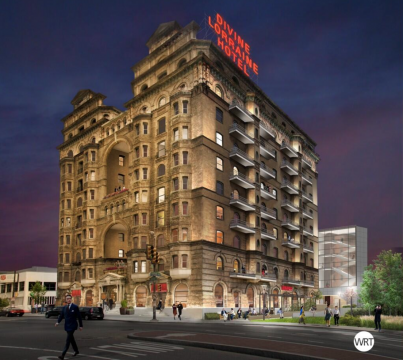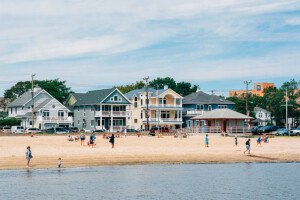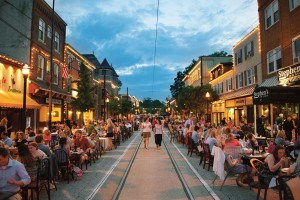Divine Lorraine Reborn: Is This Really Happening?

The new rendering of the completed Divine Lorraine renovation, via EB Realty Management’s Twitter feed
Familiar with this kind of thing? “Smack in the middle of downtown Philadelphia’s busy Broad Street sits the towering Divine Lorraine. When night falls and the rest of the city’s skyscrapers are illuminated, the former hotel and religious compound remains forebodingly dark and lifeless. Like Philadelphia wasn’t scary enough.” (That’s from the Daily Dot in October.) But no longer! Sometime soon, we may finally be rid of people judging Philadelphia on the abysmal condition of the Divine Lorraine. Scaffolding is up around the lower levels of the building, most graffiti has been washed off the exterior, and now we have a new rendering from developer Eric Blumenfeld of the future Divine Lorraine at night: occupied, open to the street, with the big sign relit in red neon and lighting on the facade. Scary no more.
Completed in 1894, the 11-story tower on North Broad was one of the city’s first high rises. It’s been vacant since 1999, when Father Divine’s struggling Universal Peace Mission Movement sold it after using the building for almost 60 years. It was partially maintained until 2006, and since then has rapidly deteriorated and become the city’s most prominent symbol of urban blight.
Blumenfeld bought the building in October 2012 for more than $8 million after a previous developer’s plan to convert the building into luxury housing fell through. Blumenfeld, who has bet big on North Broad, came up with a conceptual plan to make an apartment-filled Divine Lorraine the centerpiece of a several block-long development including, among other things, new public school facilities and practice facilities for the 76ers. (So much for that.)
But skepticism about the project’s viability grew as the Divine Lorraine remained vacant and blighted and Blumenfeld faced a court battle with a former associate over $37 million. Earlier this year, frustrated local artist Caryn Kunkle created a petition proposing taking the property from Blumenfeld via eminent domain to create an “Interactive Museum of Contemporary Art” for Philadelphia. We don’t find it shocking that that didn’t happen.
And then, just over a month ago, the Inquirer’s Jennifer Lin reported that Billy Procida, a real estate lender from New Jersey, planned to lend $31.5 million to get Blumenfeld’s project going. Procida has developed $2 billion worth of projects and specializes in turnaround neighborhoods, like Tribeca and the South Bronx in New York City. Now preliminary work has begun on the building: in addition to the scaffolding and graffiti removal, the Architect’s Newspaper reports that construction lighting is hanging throughout the interior and a structural report on the building has been completed.
Despite all that, what’s going on in the interior hasn’t even been finalized. “We are are still currently underwritten for residential and retail but would love for the project to become a hotel, and are actively perusing this model change,” Christopher Cordaro, executive director of of Blumenfeld’s EB Realty Management, told Curbed Philly. As currently conceived, the building would have 126 apartments and 21,000 square feet of commercial space, though Blumenfeld has said that the commercial space would increase in size if the state gives the project a $5 million Redevelopment Assistance Capital Program grant.
The new rendering of the project was released by EB Realty Management on Twitter just a few days ago, and it indicates that the project architect is Philadelphia-based Wallace Roberts and Todd.
The Divine Lorraine project’s long saga:
- October 2012: Blumenfeld buys back Divine Lorraine Hotel; apartments, eateries planned [Philadelphia Real Estate Blog]
- November 2012: New possibilities for the once grand hotel Divine Lorraine [Newsworks]
- June 2013: Pressed by Caplan for $37M, Blumenfeld says ‘nothing gonna stop’ Divine Lorraine rebuild [Philadelphia Inquirer]
- January 2014: Petition Started to Turn Divine Lorraine Into an “Interactive Museum of Contemporary Art” [Ticket]
- May 2014: New hope – and funding – for Divine Lorraine [Philadelphia Inquirer]
- June 2014: Change of Plans for The Divine Lorraine on North Broad Street? [Curbed Philly]


